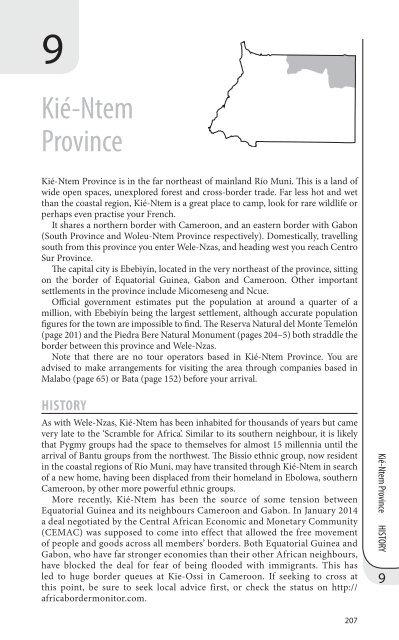Equatorial Guinea
Equatorial%20Guinea%20sample%20chapter_3ZIN
Equatorial%20Guinea%20sample%20chapter_3ZIN
You also want an ePaper? Increase the reach of your titles
YUMPU automatically turns print PDFs into web optimized ePapers that Google loves.
9<br />
p<br />
Kié-Ntem<br />
Province<br />
Kié-Ntem Province is in the far northeast of mainland Río Muni. This is a land of<br />
wide open spaces, unexplored forest and cross-border trade. Far less hot and wet<br />
than the coastal region, Kié-Ntem is a great place to camp, look for rare wildlife or<br />
perhaps even practise your French.<br />
It shares a northern border with Cameroon, and an eastern border with Gabon<br />
(South Province and Woleu-Ntem Province respectively). Domestically, travelling<br />
south from this province you enter Wele-Nzas, and heading west you reach Centro<br />
Sur Province.<br />
The capital city is Ebebiyín, located in the very northeast of the province, sitting<br />
on the border of <strong>Equatorial</strong> <strong>Guinea</strong>, Gabon and Cameroon. Other important<br />
settlements in the province include Micomeseng and Ncue.<br />
Official government estimates put the population at around a quarter of a<br />
million, with Ebebiyín being the largest settlement, although accurate population<br />
figures for the town are impossible to find. The Reserva Natural del Monte Temelón<br />
(page 201) and the Piedra Bere Natural Monument (pages 204–5) both straddle the<br />
border between this province and Wele-Nzas.<br />
Note that there are no tour operators based in Kié-Ntem Province. You are<br />
advised to make arrangements for visiting the area through companies based in<br />
Malabo (page 65) or Bata (page 152) before your arrival.<br />
HISTORY<br />
As with Wele-Nzas, Kié-Ntem has been inhabited for thousands of years but came<br />
very late to the ‘Scramble for Africa’. Similar to its southern neighbour, it is likely<br />
that Pygmy groups had the space to themselves for almost 15 millennia until the<br />
arrival of Bantu groups from the northwest. The Bissio ethnic group, now resident<br />
in the coastal regions of Río Muni, may have transited through Kié-Ntem in search<br />
of a new home, having been displaced from their homeland in Ebolowa, southern<br />
Cameroon, by other more powerful ethnic groups.<br />
More recently, Kié-Ntem has been the source of some tension between<br />
<strong>Equatorial</strong> <strong>Guinea</strong> and its neighbours Cameroon and Gabon. In January 2014<br />
a deal negotiated by the Central African Economic and Monetary Community<br />
(CEMAC) was supposed to come into effect that allowed the free movement<br />
of people and goods across all members’ borders. Both <strong>Equatorial</strong> <strong>Guinea</strong> and<br />
Gabon, who have far stronger economies than their other African neighbours,<br />
have blocked the deal for fear of being flooded with immigrants. This has<br />
led to huge border queues at Kie-Ossi in Cameroon. If seeking to cross at<br />
this point, be sure to seek local advice first, or check the status on http://<br />
africabordermonitor.com.<br />
Kié-Ntem Province HISTORY<br />
9<br />
207


